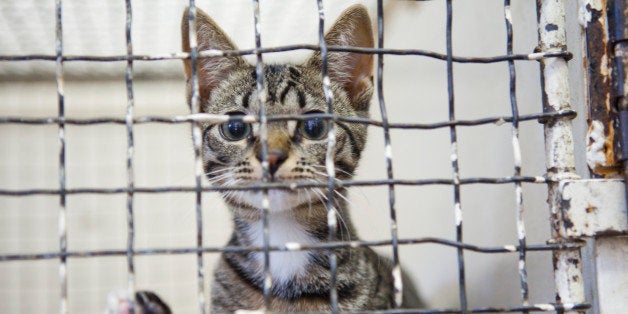
Anyone who’s watched an episode of “Hoarders” on A&E knows it’s not just stuff that’s the problem. Sometimes, the crippling disorder can also put animals in harm's way.
According to the Anxiety and Depression Association of America, reports to animal control and law enforcement agencies have increased steadily over the last decade.
About 40 percent of object hoarders also tend to accumulate and eventually neglect animals.
Unraveling the cause of animal hoarding can be as complicated as assembling a 1,000-piece jigsaw puzzle in the dark. But the American Society for the Prevention of Cruelty to Animals (ASPCA) has been chipping away at the problem in New York City through its Cruelty Intervention Advocacy (CIA) program. Since April 2010, humane law enforcement agents, family members and social workers have joined forces to rescue more than 4,000 animals. Pets receive vital veterinary care or forever homes, and hoarders also get assistance, including access to education, housing or legal aid.
“We look at the whole picture,” says CIA program Director Allison Cardona. “We are animal advocates, but in order to help animals, we also have to help the people.”
Identifying hoarders – and providing necessary assistance – is the first step toward recovery. With that in mind, Cardona and CIA social worker Carrie Jedlicka share four things you should know about animal hoarders.
1. Hoarding isn’t just about the number of animals.
Most people associate animal hoarding with images of the “crazy cat lady” whose home is overrun with felines, but the problem is broader than that. (About 76 percent of the ASPCA cases involve cats, and 67 percent involve female clients.) Cardona notes that the animals’ living conditions play a bigger role in determining whether there is a problem. After receiving a complaint, agents try to assess whether individuals can address pets’ basic needs, including sanitation and veterinary care.
“Are conditions deteriorating?” she says, “Conditions don’t get better on their own. Often there’s a lack of insight that there’s a problem. The animal has a runny nose and the person is telling us they don’t see that. Often the impulse is to continue to take in animals, even when they do not have the resources.”
2. Reasons for hoarding can vary.
Anxiety and depression frequently fuel the need to hoard animals, says Jedlicka. Traumatic events from early childhood often play a part as well. In many cases, individuals lack stable parent figures and find that animals provide a safer, more loving relationship. Jedlicka says hoarders misplace their grief and direct that attention to their animals, falling into one of three categories: overwhelmed caregiver, rescuer or exploiter hoarder. The overwhelmed caregiver passively accumulates animals, starting with a few. Often the pets are not spayed or neutered, so the owner quickly gets overwhelmed.
“Most are open to intervention and know they need help,” she says. “It wasn’t their intention to get into that situation.”
Rescuers take up the bulk of CIA cases, Jedlicka says. They actively accumulate, typically serving as the neighbor who is willing to take in strays.
“It’s a guilt-free place for people to take their animals,” she says. “People don’t realize the extent of the hoarder’s problem.”
The third group, called exploiter hoarders, is often the hardest to address, according to Jedlicka, because these hoarders lack awareness of the animals’ health or diminished living conditions. When faced with exploiter hoarders, the ASPCA often calls in law enforcement to address the problem.
3. The warning signs are usually visible.
“When you have a large number of animals, it’s hard for the pet owner to spend time with the animals,” Cardona says. “The animals become fearful or shy. There’s also a lack of veterinary care and pets often are not spayed or neutered.”
Having a lot of animals in the home also causes an odor, Jedlicka says, so follow your nose. While New York City has no limit on the number of pets allowed in a household, Cardona notes that municipalities set guidelines for pet ownership. Research the laws for your area – and report individuals who may be breaking the rules.
4. Rehabilitation is possible.
Cardona shared the story of a woman who lived with about 50 cats in a cluttered New York apartment. Known as the neighborhood rescuer, she initially refused the ASPCA’s offers to help the animals she loved. Simply removing the animals can lead to more hoarding, according to the Anxiety and Depression Association of America. Cognitive behavioral treatment (CBT) is recommended to address the root cause for hoarding and to reduce the chance of repeat behavior. A strong network of support also helps. In this instance, Cardona says that the woman’s family helped clean the apartment and now stays in contact with her on a regular basis.
“The big component is just building a strong trusting relationship with the client,” Jedlicka says. “Every case is unique and we definitely try to treat it as such. … A trusting relationship goes a long way.”
More resources: If you live in New York and suspect animal hoarding in your community, call the Cruelty Intervention Advocacy program at 1-877-THE-ASPCA or email enforcement@aspca.org. For information on animal hoarding and treatment options, visit the Anxiety and Depression Association of America.
